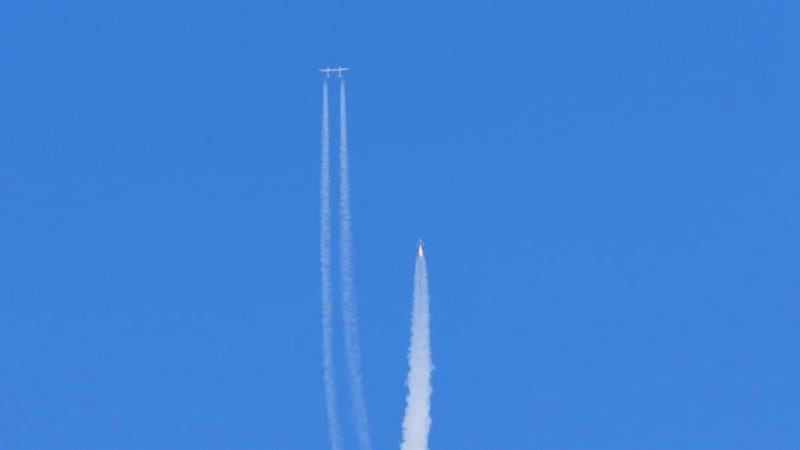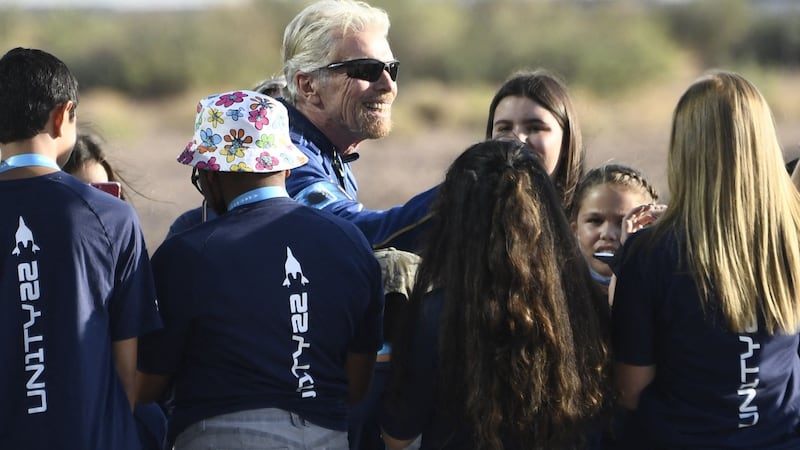Richard Branson touched the edge of space on Sunday morning, fulfilling a life-long ambition and grabbing bragging rights from rival Jeff Bezos in the race to open suborbital space to commercial tourism.
The 70-year-old Virgin founder and five other crew reached a height of about 86km above the New Mexico desert to break into the lower reaches of space at 9.26am local time (4.26pm Irish time). Their Virgin Galactic spacecraft had been carried aloft under a specially designed carrier plane, before firing its rocket to climb at three times the speed of sound.
The launch followed a 17-year quest marked by delay and disappointment, during which Mr Branson burnt through more than $1 billion (€840 million) of his personal fortune. The flight had been pushed back by 90 minutes after a midnight storm blew up dust from the barren scrubland, delaying the craft’s rollout from its hangar at Spaceport America.
‘Experience of a lifetime’
From on board, Mr Branson called it the “experience of a lifetime”.
The flight comes nine days before Amazon founder Jeff Bezos is due to go higher in a rocket built by his private space company, Blue Origin.

The billionaires’ personal escapades cap a race to prove that their rocket companies are finally safe for commercial operations, opening up suborbital space as a tourist destination.
Mr Branson had been scheduled to join a later Virgin Galactic test flight, but Sunday’s ride was hastily announced two weeks ago when it looked like he would be beaten to zero gravity by Mr Bezos.
In a sign of the marketing war for space tourists that lies ahead, Blue Origin poured cold water on Mr Branson’s feat even before he took to the sky on Sunday. It pointed out that Virgin Galactic’s space plane does not reach the Karman line – the point, 100km above the Earth, that marks the internationally recognised boundary of outer space.

The criticism forced Mr Branson on to the defensive in the days leading up to his flight. He pointed out that the US considers space to begin at a height of 80km and claimed that his company’s passengers would spend the same four minutes in zero gravity as Blue Origin’s.
Over the weekend, the Bezos camp also dismissed the VSS Unity as a “high altitude aeroplane” and highlighted supposed safety shortcomings, including the lack of an escape system in the event of an emergency and the fact that it has risen above 80km only three times before.
But in New Mexico, the moment belonged to Mr Branson. Hundreds of press, company employees and guests gathered in the pre-dawn darkness to witness his launch, a testament to his skills as a master showman who has long used his appetite for personal risk-taking to polish the Virgin brand. Elon Musk, another billionaire space entrepreneur, visited Mr Branson on Sunday morning to wish him well and watch the launch.
Accident
Virgin Galactic moved into the Spaceport two years ago but until Sunday had held only one test flight since then. It had been delayed for years by a 2014 accident when one of its spaceships broke apart, killing a test pilot. An earlier accident during a rocket test on the ground killed three employees who had been contracted to build Virgin Galactic’s spaceship.
Sunday’s flight – and Mr Branson’s part in it – is ostensibly part of the series of tests that Virgin Galactic needs to go through before it opens up fully to commercial operations. The Virgin founder was said to be about to help assess whether the company had met its “cabin and customer experience objectives”.
Two more test flights are planned before full commercial operations begin.
– Copyright The Financial Times Limited 2021












